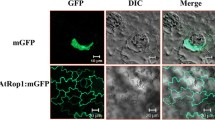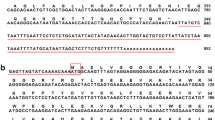Abstract
The Arabidopsis bypass1 mutant (bps1) exhibits defective shoot and root growth that is associated with constitutive production of a root-derived carotenoid-related signal (Van Norman et al., Curr Biol 14:1739–1746, 2004). Since the identity of the signal and the function of BPS1 are still unknown, we investigated effects of BPS1 depletion in Nicotiana benthamiana to elucidate BPS1 function in plant growth and development. The predicted protein of NbBPS1, a BPS1 homolog of N. benthamiana, contains a central transmembrane domain, and a NbBPS1:GFP fusion protein was mainly associated with the endoplasmic reticulum. Virus-induced gene silencing (VIGS) of NbBPS1 resulted in pleiotrophic phenotypes, including growth retardation and abnormal leaf development. At the cellular level, the plants exhibited hyperproliferation of the cambial cells and defective xylem differentiation during stem vascular development. Hyperactivity of the cambium was associated with an elevated auxin and cytokinin response. In contrast, the leaves had reduced numbers of cells with increased cell size and elevated endoreduplication. Cell death in NbBPS1 VIGS leaves started with vacuole collapse, followed by degeneration of the organelles. Interestingly, these phenotypes were mainly caused by silencing of NbBPS1 in the aerial parts of the plants, different from the case of the Arabidopsis bps1 mutant. These results suggest that NbBPS1 plays a role in the control of cell division and differentiation in the cambium of N. benthamiana, and BPS homologs may have a diverse function in different tissues and in different species.








Similar content being viewed by others
References
Ahn J-W, Kim M, Lim JH, Kim G-T, Pai H-S (2004) Phytocalpain controls the proliferation and differentiation fates of cells in plant organ development. Plant J 38:969–981
Aloni R, Schwalm K, Langhans M, Ullrich CI (2003) Gradual shifts in sites of free-auxin production during leaf-primordium development and their role in vascular differentiation and leaf morphogenesis in Arabidopsis. Planta 216:841–853
Baima S, Possenti M, Matteucci A, Wisman E, Altamura MM, Ruberti I, Morelli G (2001) The Arabidopsis ATHB-8 HD-zip protein acts as a differentiation-promoting transcription factor of the vascular meristems. Plant Physiol 126:643–655
Bennett T, Sieberer T, Willett B, Booker J, Luschnig C, Leyser O (2006) The Arabidopsis MAX pathway controls shoot branching by regulating auxin transport. Curr Biol 16:553–563
Booker J, Auldridge M, Wills S, McCarty D, Klee H, Leyser O (2004) MAX3/CCD7 is a carotenoid cleavage dioxygenase required for the synthesis of a novel plant signaling molecule. Curr Biol 14:1232–1238
Bouvier F, Suire C, Mutterer J, Camara B (2003) Oxidative remodeling of chromoplast carotenoids: identification of the carotenoid dioxygenase CsCCD and CsZCD genes involved in Crocus secondary metabolite biogenesis. Plant Cell 15:47–62
Cho HS, Lee SS, Kim KD, Kim SJ, Hwang I, Lim JS, Park YI, Pai H-S (2004) DNA gyrase is involved in chloroplast nucleoid partitioning. Plant Cell 16:2665–2682
Cho M, Lee OR, Ganguly A, Cho HT (2007) Auxin-signaling: short and long. J Plant Biol 50:79–89
Christensen SK, Dagenais N, Chory J, Weigel D (2000) Regulation of auxin response by the protein kinase PINOID. Cell 100:469–478
D’Agostino IB, Deruere J, Kieber JJ (2000) Characterization of the response of the Arabidopsis response regulator gene family to cytokinin. Plant Physiol 124:1706–1717
De Veylder L, Beeckman T, Beemster GT, Krols L, Terras F, Landrieu I, van der Schueren E, Maes S, Naudts M, Inzé D (2001) Functional analysis of cyclin-dependent kinase inhibitors of Arabidopsis. Plant Cell 13:1653–1668
den Boer BG, Murray JA (2000) Triggering the cell cycle in plants. Trends Cell Biol 10:245–250
Dewitte W, Murray JA (2003) The plant cell cycle. Annu Rev Plant Biol 54:235–264
Donnelly PM, Bonetta D, Tsukaya H, Dengler RE, Dengler NG (1999) Cell cycling and cell enlargement in developing leaves of Arabidopsis. Dev Biol 215:407–419
Foo E, Turnbull CG, Beveridge CA (2001) Long-distance signaling and the control of branching in the rms1 mutant of pea. Plant Physiol 126:203–209
Francis D (2007) The plant cell cycle – 15 years on. New Phytol 174:261–278
Fukuda H (2004) Signals that control plant vascular cell differentiation. Nat Rev Mol Cell Biol 5:379–391
Fukuda H, Komamine A (1980) Direct evidence for cytodifferentiation to tracheary elements without intervening mitosis in a culture of single cells isolated from the mesophyll of Zinnia elegans. Plant Physiol 65:61–64
Gälweiler L, Guan C, Müller A, Wisman E, Mendgen K, Yephremov A, Palme K (1998) Regulation of polar auxin transport by AtPIN1 in Arabidopsis vascular tissue. Science 282:2226–2230
Gegas VC, Doonan JH (2006) Expression of cell cycle genes in shoot apical meristems. Plant Mol Biol 60:947–961
Groover A, Jones AM (1999) Tracheary element differentiation uses a novel mechanism coordinating programmed cell death and secondary cell wall synthesis. Plant Physiol 119:375–384
Gutierrez C (2005) Coupling cell proliferation and development in plants. Nat Cell Biol 7:535–541
Hardtke CS, Berleth T (1998) The Arabidopsis gene MONOPTEROS encodes a transcription factor mediating embryo axis formation and vascular development. EMBO J 17:1405–1411
Joubès J, Chevalier C (2000) Endoreduplication in higher plants. Plant Mol Biol 43:735–745
Jung JH, Park CM (2007) Vascular development in plants: specification of xylem and phloem tissues. J Plant Biol 50:301–305
Kessler S, Sinha N (2004) Shaping up: the genetic control of leaf shape. Curr Opin Plant Biol 7:65–72
Kim M, Lim J-H, Ahn CS, Park K, Kim GT, Kim WT, Pai H-S (2006) Mitochondria-associated hexokinases play a role in the control of programmed cell death in Nicotiana benthamiana. Plant Cell 18:2341–2355
Kosugi S, Ohashi Y (2003) Constitutive E2F expression in tobacco plants exhibits altered cell cycle control and morphological change in a cell type-specific manner. Plant Physiol 132:2012–2022
Lee YJ, Kim DH, Kim Y-W, Hwang I (2001) Identification of a signal that distinguishes between the chloroplast outer envelope membrane and the endomembrane system in vivo. Plant Cell 13:2175–2190
Liu JX, Srivastava R, Che P, Howell SH (2007) An endoplasmic reticulum stress response in Arabidopsis is mediated by proteolytic processing and nuclear relocation of a membrane-associated transcription factor, bZIP28. Plant Cell 19:4111–4119
Mähönen AP, Bonke M, Kauppinen L, Riikonen M, Benfey PN, Helariutta Y (2000) A novel two-component hybrid molecule regulates vascular morphogenesis of the Arabidopsis root. Genes Dev 14:2938–2943
Mähönen AP, Bishopp A, Higuchi M, Nieminen KM, Kinoshita K, Tormakangas K, Ikeda Y, Oka A, Kakimoto T, Helariutta Y (2006) Cytokinin signaling and its inhibitor AHP6 regulate cell fate during vascular development. Science 311:94–98
Nieminen KM, Kauppinen L, Helariutta Y (2004) A weed for wood? Arabidopsis as a genetic model for xylem development. Plant Physiol 135:653–659
Obara K, Kuriyama H, Fukuda H (2001) Direct evidence of active and rapid nuclear degradation triggered by vacuole rupture during programmed cell death in Zinnia. Plant Physiology 125:615–626
Park J-A, Ahn J-W, Kim Y-K, Kim SJ, Kim J-K, Kim WT, Pai H-S (2005) Retinoblastoma protein regulates cell proliferation, differentiation, and endoreduplication in plants. Plant J 42:153–163
Parker G, Schofield R, Sundberg B, Turner S (2003) Isolation of COV1, a gene involved in the regulation of vascular patterning in the stem of Arabidopsis. Development 130:2139–2148
Pineau C, Freydier A, Ranocha P, Jauneau A, Turner S, Lemonnier G, Renou JP, Tarkowski P, Sandberg G, Jouanin L, Sundberg B, Boudet AM, Goffner D, Pichon M (2005) hca: An Arabidopsis mutant exhibiting unusual cambial activity and altered vascular patterning. Plant J 44:271–289
Ramirez-Parra E, Desvoyes B, Gutierrez C (2005) Balance between cell division and differentiation during plant development. Int J Dev Biol 49:467–477
Ratcliff F, Martin-Hernansez AM, Baulcombe DC (2001) Tobacco rattle virus as a vector for analysis of gene function by silencing. Plant J 25:237–245
Scarpella E, Meijer AH (2004) Pattern formation in the vascular system of monocot and dicot plant species. New Phytol 164:209–242
Simkin AJ, Schwartz SH, Auldridge M, Taylor MG, Klee HJ (2004) The tomato carotenoid cleavage dioxygenase 1 genes contribute to the formation of the flavor volatiles beta-ionone, pseudoionone, and geranylacetone. Plant J 40:882–892
Sorefan K, Booker J, Haurogné K, Goussot M, Bainbridge K, Foo E, Chatfield S, Ward S, Beveridge C, Rameau C, Leyser O (2003) MAX4 and RMS1 are orthologous dioxygenase-like genes that regulate shoot branching in Arabidopsis and pea. Genes Dev 17:1469–1474
Stirnberg P, van de Sande K, Leyser HMO (2002) MAX1 and MAX2 control shoot lateral branching in Arabidopsis. Development 129:1131–1141
Sugimoto-Shirasu K, Roberts K (2003) “Big it up”: endoreduplication and cell-size control in plants. Curr Opin Plant Biol 6:544–553
Tamura K, Dudley J, Nei M, Kumar S (2007) MEGA4: Molecular Evolutionary Genetics Analysis (MEGA) software version 4.0. Mol Biol Evol 24:1596–1599
Ulmasov T, Murfett J, Hagen G, Guilfoyle TJ (1997) Aux/IAA proteins repress expression of reporter genes containing natural and highly active synthetic auxin response elements. Plant Cell 9:1963–1971
Valentine T, Shaw J, Blok VC, Phillips MS, Oparka KJ, Lacomme C (2004) Efficient virus-induced gene silencing in roots using a modified tobacco rattle virus vector. Plant Physiol 136:3999–4009
Van Norman JM, Sieburth LE (2007) Dissecting the biosynthetic pathway for the bypass1 root-derived signal. Plant J 49:619–628
Van Norman JM, Frederick RL, Sieburth LE (2004) BYPASS1 negatively regulates a root-derived signal that controls plant architecture. Curr Biol 14:1739–1746
Ye ZH (2002) Vascular tissue differentiation and pattern formation in plants. Annu Rev Plant Biol 53:183–202
Acknowledgements
The authors wish to thank Dr. Tom J. Guilfoyle (University of Missouri, USA) for providing the DR::GUS construct, and Drs. Jeong Ho Roh and Hye Kyung Rhee (National Horticultural Research Institute, Korea) for providing a technical help for flow cytometry. This research was supported by grants from the Plant Diversity Research Center of the 21st Century Frontier Research Program, a KOSEF grant (M10749000002-07N4900-00210), and the Plant Signaling Network Research Center (at Korea University) of the Science Research Center Program, all of which are funded by the Ministry of Science and Technology of Korea.
Author information
Authors and Affiliations
Corresponding authors
Additional information
Y. W. Kang and R. N. Kim contributed equally to this work.
GenBank accession numbers: EU243336 (NbBPS1) and EU243335 (NbBPS2).
Electronic supplementary material
11103_2008_9384_MOESM1_ESM.ppt
Supplementary Fig. 1 Phenotype variability in the NbBPS1 VIGS lines and silencing of NbBPS1 in the stem. (a) Relative phenotype severity. The average number of abnormal leaves of TRV:BPS1(U) lines was approximately 57% of that of TRV:BPS1(C) lines at 25 DAI (7.3 leaves; n = 50). (b) Semiquantitative RT-PCR analysis of the NbBPS1 mRNA levels in the stem using BPS1-C2 primers. RT-PCR showed significantly reduced PCR products in both lines relative to the TRV:GFP lines, indicating that the endogenous level of NbBPS1 transcripts is reduced in the stem tissue
Supplementary Fig. 2 Effects of fluridone treatment on the NbBPS1 VIGS phenotype. (a) Fluridone (FL) treatment fully rescued the growth arrest and partially rescued the abnormal leaf morphology of the NbBPS1 VIGS plants at 22 DAI. VIGS plants were irrigated with 0.1% ethanol with or without fluoridone (0, 0.1 and 10 μM) from 2 DAI to 22 DAI. (b) Effects of fluridone on plant height of the NbBPS1 VIGS plants at 22 DAI. Relative height (%) was calculated comparing to the height of TRV control treated with 0.1% ethanol (PPT 1735 kb)
Rights and permissions
About this article
Cite this article
Kang, Y.W., Kim, R.N., Cho, H.S. et al. Silencing of a BYPASS1 homolog results in root-independent pleiotrophic developmental defects in Nicotiana benthamiana . Plant Mol Biol 68, 423–437 (2008). https://doi.org/10.1007/s11103-008-9384-7
Received:
Accepted:
Published:
Issue Date:
DOI: https://doi.org/10.1007/s11103-008-9384-7




